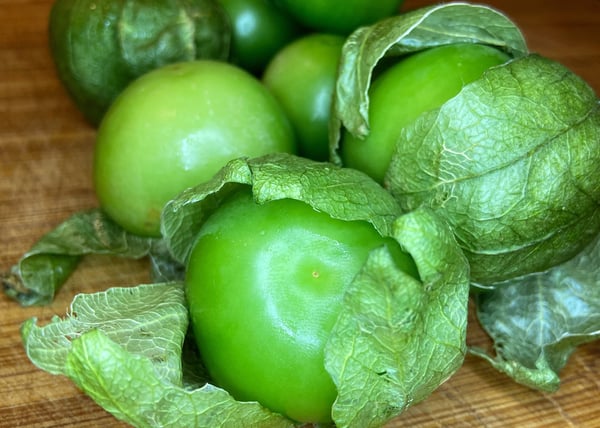A very good friend of mine gave me this recipe, and we have cooked it several times now. He learned it in Mexico from his grandmother, and he comes from the city of Puebla where this is a regional dish. Grandmothers are indeed special! I learned how to bake bread from mine at a young age. Writing this triggers such wonderful memories and 40 years gone by seems as if it was only yesterday when we were baking together in my grandmother's kitchen.
The colorful Mexican pork stew looks great on a plate or served family style and as always, it’s better the next day! You can keep it in the fridge for up to three days. You could also reserve some salsa to use on your next Taco Tuesday, that will keep in the fridge for up to a week. I’m not accustomed to eating spicy food; however, the flavors in this dish are so well balanced I just can’t get enough! Some of the ingredients may not be familiar to you, but they can be found at most Mexican grocery stores, and in my case, my corner bodega.
Let’s talk about the veggies. Calabacitas are basically zucchini, just smaller in size and light yellow green inside. Chayote, also known as mirliton squash, is an edible plant belonging to the gourd family. Chayote was one of the several foods introduced to the Old World during the Columbian Exchange along with many other wonderful foods.
Pork Stew In Salsa Verde (Puerco en Salsa Verde)
Yields 4 servings
2 pounds pork shoulder
6 medium tomatillos
1 medium onion (you can use a red onion too), large diced and separated
1 bunch cilantro
3 stems of parsley
1 medium jalapeno
3 pieces serrano pepper
2 medium size calabacitas (Mexican zucchini)
1 chayote squash, peeled and quartered
2 peeled and quartered large potatoes
Salt and pepper
2 Tablespoons grapeseed, avocado or vegetable oil
For the Salsa Verde:
1. Rinse the peppers. Remove the husks from the tomatillos and rinse well to remove the sticky residue.

2. Place the peppers and tomatillos in a medium pot and cover about halfway with water. Turn the heat to medium.
3. Once the water starts to boil, check the tomatillos. They are cooked when the bottom turns yellow but the top is still green.
4. Remove the tomatillos and set aside while the peppers continue to cook until fully soft.
5. Transfer the cooked tomatillos to a blender, add a little water and half of the onion. Add one pepper at a time making sure to check the heat level by tasting and being careful not to breathe in the steam rising from the blender. It can make you choke on the spice fumes! Add salt to taste, then the cilantro and blend well, then set aside.
For the Pork Stew:
1. Set a large Dutch oven or pot over medium heat, and add the oil. Once the oil is hot, add seasoned pork pieces and brown lightly on all sides, add the rest of the onion and continue to cook until translucent.
2. Add 1/2 cup of the salsa (this is called deglazing the pan) and scrape the brown bits off the bottom of the pan (this is called fond). Add the rest of the salsa and let simmer for a while.
3. Add a little bit of salt and the chopped potatoes along a cup of water, keep simmering until the potatoes are soft (about 20 minutes), add water as needed to thin out the sauce.
4. Incorporate the peeled, diced chayote followed by the sliced calabacitas and three stems of parsley. Cover the pot and let it simmer until the vegetables are soft. You may want to adjust seasonings at this time.
This dish is so versatile. It can be served over your favorite rice with a side of refried beans, or use it as a topping on tostadas, burritos and taco style with homemade corn tortillas. You can also substitute the calabacitas with regular zucchini, and add garbanzo beans, green peas, carrots and even cabbage. The salsa really tastes delicious over any combination of vegetables you may have!
If you are interested in learning to make more authentic stews, join us for these upcoming virtual classes:
- Shrimp and Andouille Sausage Gumbo with Steamed Rice on Thursday, June 4 at 6pm CST
- Vegetarian Thai Coconut Curry on Friday, June 5 at 6pm CST
